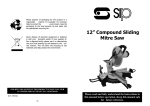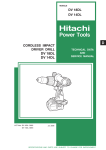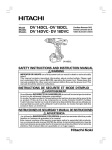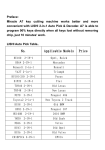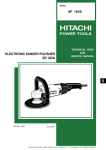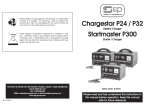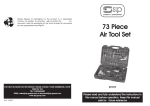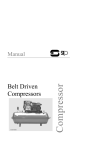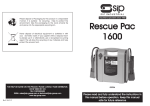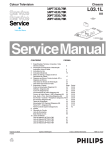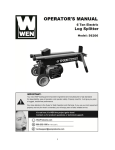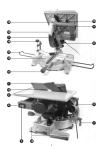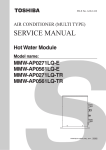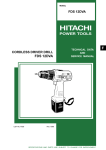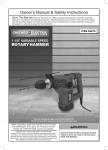Download 10 compound sliding saw
Transcript
Please dispose of packaging for the product in a responsible manner. It is suitable for recycling. Help to protect the environment, take the packaging to the local amenity tip and place into the appropriate recycling bin. Never dispose of electrical equipment or batteries in with your domestic waste. If your supplier offers a disposal facility please use it or alternatively use your local amenity tip and dispose in the correct manner. This will allow the recycling of raw materials and help protect the environment. 10” Compound Sliding Mitre Saw FOR HELP OR ADVISE ON THIS PRODUCT PLEASE CALL OUR CUSTOMER SERVICE HELP LINE : 01509 500359 REF: 051101 28 Please read and fully understand the instructions in this manual before operation. Keep this manual safe for future1reference. DECLARATION OF CONFORMITY WE SIP LTD GELDERS HALL ROAD SHEPSHED LOUGHBOROUGH LEICESTERSHIRE LE12 9NH Declare that the Sliding Compound Mitre Saw SIP Pt No: 01314 / 01324 Complies with the following EEC Directives their supporting Statutory Instruments and the relevant standard where applicable: 98/37/EC 93/68/EEC 89/336/EEC Machinery Directive Low Voltage Directive EN 61029-2-9 EN 61029-1 EN 60825-1:1994 EMC Directive EN 55014-1:2000 EN 55014-2:1997 EN 61000-3-2 /-3-11:2000 Signed: Mr Marco Ippaso Joint Managing Director Date: 28th April 2003 2 27 CONTENTS NOTES 26 PAGE 3 CONTENTS PAGE 4 GENERAL SAFETY INSTRUCTIONS PAGE 5 SPECIFIC SAFETY INSTRUCTIONS PAGE 7 TECHNICAL SPECIFICATIONS PAGE 7 ACCESSORIES PAGE 8 GETTING TO KNOW YOUR SAW PAGE 9 SAFETY SYMBOLS PAGE 9 ELECTRICAL CONNECTION PAGE 10 WARRANTY PAGE 10 INSTALLATION / ASSEMBLY PAGE 13 ADJUSTMENTS PAGE 15 OPERATING INSTRUCTIONS PAGE 19 MAINTENANCE PAGE 21 EXPLODED DIAGRAM PAGE 22 PARTS LIST PAGE 27 DECLARATION OF CONFORMITY 3 GENERAL SAFETY INSTRUCTIONS 1. KNOW YOUR POWER TOOL. Read the owner's manual carefully. Learn the tool's applications and limitations, as well as the specific potential hazards particular to it. 2. KEEP GUARDS IN PLACE and working order. 3. REMOVE ADJUSTING KEYS AND WRENCHES. Form habit of checking to see that keys and adjusting wrenches are removed from tool before turning it on. 4. KEEP WORK AREA CLEAN, Cluttered areas and benches invite accidents. 5. DON’ T USE IN DANGEROUS ENVIRONMENT, Don't use power tools in damp or wet locations, or expose them to rain. Keep work area well lighted. Don't use tool in presence of flammable liquids or gases. 6. KEEP CHILDREN AWAY. All visitors should be kept safe distance from work area. 7. MAKE WORKSHOP CHILD PROOF with padlocks, master switches or by removing starter keys. 8. DON'T FORCE TOOL. It will do the job better and safer at the rate for which it was designed. 9. USE RIGHT TOOL. Don't force tool or attachment to do a job for which it was not designed; for example, don't use circular saw for cutting tree limbs or logs. 10. WEAR PROPER APPAREL. Do not wear loose clothing, gloves, neckties, rings, bracelets, or - other jewellery which may get caught in moving parts. Non-slip footwear is recommended. Wear protective hair covering to contain long hair. 11. ALWAYS USE SAFETY GLASSES. Also use face or dust mask if cutting operation is dusty, everyday eyeglasses only have impact resistant lenses, they are NOT safety glasses. 12. SECURE WORK. Use clamps or a vice to hold work when practical. It's safer than using your hand and it frees both hands to operate tool. 13. DON'T OVERREACH. Keep proper footing and balance at all times. 14. MAINTAIN TOOLS WITH CARE. Keep tools sharp and clean for best and safest performance. Follow instructions for lubricating and changing accessories. 15. DISCONNECT TOOL FROM POWER SUPPLY before servicing; when changing accessories such as blades, bits, cutters, and the like. 16. REDUCE THE RISK OF UNINTENTIONAL STARTING. Make sure switch is in off position before connecting to power source. 4 PARTS LIST….cont Part No. Description. Part No. Description. 113. baffle chip 141. Transparent Guard 114. Rear holder 142. Clamping ring 115. Seal 143. Screw for guard 116. Ball bearing 144. Limiting screw 117. Bar holder 145. Wing nut 118. Hexagon nut M8 146. Cross pan head screw M5x14 119. Locking nut M8x16 147. locating base 120. Side pull rod 148. plastic plate 121. Main pull rod 149. seal plate 122. Knob 150. seal ring 123. O ring 151. spring 124. Limiting screw 152. self-lock holder 125. Latch 153. screw 126. Front base 154. extended foot 127. Pole 128. Connecting plate 129. Screw for connecting plate 130. Locking screw M5x10 131. Cross pan head screw M3x8 132. Battery Box 133. Spring A 134. Copper chip 135. Swith HS-G5 136. Battery 137. Spring B 138. Battery Box Cover 139. Lining plate for guard 140. Spring ring 25 SAFETY INSTRUCTIONS GENERAL SAFETY INSTRUCTIONS....cont PARTS LIST...cont Part No. Description Part No. Description. 17. USE RECOMMENDED ACCESSORIES. Consult the owner's manual for recommended accessories, the use of improper accessories may cause risk of injury to persons. 18. NEVER STAND ON TOOL. Serious injury could occur if the tool is tipped or if the cutting tool is accidentally contacted. 19. CHECK DAMAGED PARTS Before use of the tool, a guard or other part that is damaged should be carefully checked to determine that it will operate properly and perform its intended function - check for alignment of moving parts binding of moving parts, its operation. A guard or other part that is damaged should be properly repaired or replaced. 20. NEVER LEAVE TOOL RUNNING UNATTENDED. Turn the power off and Don't leave tool until it comes to a complete stop. 57. Laser holder 85. Capacitor 0.33Uf 58. Pan tapping screw 86. Right handle 59. Laser 87. Switch HY15 60. Bearing 6002 88. Square shaped inductor 61. Bearing clamping plate 89. Connecting Pillar 62. Armature 90. Cable clamping plate 63. Bearing 6000 91. Cable Sleeve 64. Bearing Sleeve 92. Cable plug 65. Holding screw 93. Supporter 66. Hexagon screw M4x10 94. Hexagon screw M8x25 67. Push pin 95. Hexagon Nut M6 68. Wind guard ring 96. Hexagon screw M6x35 69. Pan tapping screw ST5x72 97. Elastic round Latch 70. Spring washer 5 98. Connecting shaft 71. Flat washer 5 99. Indicator 72. Stator 100. Cover plate 73. Housing 101. Seal 74. Label 102. Scale label 75. Soft start box 103. Spring 76. Cross pan head screw M5x27 104. Locking wheel Battery: 77. Pan tapping screw ST4x12 105. Flat washer 16 78. Rear cover 106. Waved shape washer16 79. Pan tapping screw ST4x16 107. Locking nut M16 80. Carbon brush holder 108. Locking pole 81. Carbon brush 109. Locking Knob 82. Brush cap 110. Spring 83. Pan tapping screw ST4x20 111. Screw When replacing batteries. Always replace both batteries; Do not mix old batteries with new ones. Prevent all batteries from short circuiting. Do not store batteries where the temperature may rise above 50°C. Dispose of batteries in the correct manner; never burn the batteries. Never attempt to open batteries. In case of battery leakage, carefully remove the liquid using a cloth. Avoid skin or eye contact. Do not swallow. In case of skin or eye contact, rinse with clean water and seek medical advice. 84. Left handle 112. Support pin 24 SPECIFIC SAFETY INSTRUCTIONS WARNING: LASER. Warning! The laser beam can potentially cause severe eye damage. Never look or stare directly into the laser beam. During use, do not point the laser beam at people, directly or indirectly through reflecting surfaces. This laser complies with class 2 according to EN 60825-1:1994. The unit includes no servicing components. Do not open the housing for any reason. If the unit is faulty/damaged, have it repaired/replaced by an authorized repair agent. 5 SPECIFIC SAFETY INSTRUCTIONS….cont PARTS LIST 1. Use only the blade flange specified for this tool. 2. Be careful not to damage the arbor, flange (especially the installing surface) or bolt. Damage to these parts could result in blade breakage. 3. Make sure that the table base is properly secured so it will not move during operation. 4. For your safety; remove the chippings and work debris etc. from the table top and from inside the extraction port before each operation. 5. Avoid cutting nails; Remove all nails from the work-piece before cutting. 6. Make sure the shaft lock is released before switching on the saw. 7. Be sure that the blade does not come into contact with the base when the blade is in the lowest position. 8. Hold the handle firmly. 9. Do not perform any operation freehand. The work-piece must be secured firmly against the base and guide fence with the vice during all operations; Using your hand may cause severe injury. 10. Keep hands out of path of saw blade, never reach around saw blade. 11. Make sure the blade is clear of the work-piece before the switch is turned on. 12. Before making the first cut using the saw, let it run for a while; Watch for vibration or wobbling that could indicate poor installation or a poorly balanced blade. Adjust or replace as necessary. 13. Allow the blade to run up to full speed before cutting. 14. Stop operation immediately if you notice anything abnormal. 15. Do not attempt to lock the trigger in the on position. 16. Wait for saw blade to stop completely and remove from mains supply before servicing or adjusting tool. 17. Be alert at all times, especially during repetitive, monotonous operations. Don't be lulled into a false sense of security. Blades are extremely unforgiving. 18. Use of improper accessories such as abrasive wheels may cause damage to the saw and surrounding area as well as increasing the risk of injury. 19. Turn off the saw and wait for it to complete stop before moving workpiece or changing settings. 20. To reduce the risk of injury, return, carriage to the full rear position after each crosscut operation. 21. Do not modify the saw to do tasks other than those intended. Part No. 6 Description. Part No. Description. 1. Extension support 29. Locking Knob 2. Rubber feet 30. Clamping pole 3. Screw M5x20 31. Clamping ring 4. Self-Locking nut M12 32. Clamping plate 5. Flat washer M12 33. Clamping knob 6. Waved shape washer 34. Hexagon screw M8x20(left) 7. Base 35. washer 8. Cross pan head screw M4x10 36. Upper clamping plate 9. Slippery washer 37. saw blade 10. Screw M5x10 38. Bottom clamping plate 11. Clamping spring 39. Cross pan head screw M4x16 12. Clamping plate 40. Spring washer 4 13. Locking nut M6 41. Flat washer 4 14. Locking Pillar 42. Clamping plate 15. Location handle 43. Flat washer 16. Stop for lock handle 44. Transmission shaft 17. Lock handle 45. Bearing 18. Screw M5x10 46. Bearing housing 19. Lock handle supporter 47. Elastic Collar D20 20. Screw for lock handle 48. Gear 21. Lining plate left 49. Elastic Collar D17 22. Lining plate right 50. Needle bearing HK1210 23. Scale pointer 51. Cross pan head screw M4x55 24. Round base 52. Frame 25. Screw for round base 53. Locking shaft 26. Location ruler 54. Latch D3x16 27. Flat washer 8 55. Spring 28. Hexagon screw M8x35 56. Cross pan head screw M4x12 23 TECHNICAL SPECIFICATIONS EXPLODED DIAGRAM Part number 01314 01324 Input voltage 230v / 50hz 110v / 50hz Power 2000 watts 1600 watts Maximum speed (no load) 4200rpm 4200rpm Blade size 255mm x 16mm 255mm x 16mm Mitre range - 55° to +55° - 55° to +55° Cross cut capacity (mm) @ 90° x 90° 90(h) x 300(d) 90(h) x 300(d) Mitre cut capacity (mm) @ 90° x 45° 90(h) x 200(d) 90(h) x 200(d) Bevel cut capacity (mm) @ 45° x 90° 55(h) x 300(d) 55(h) x 300(d) Compound mitre cut capacity (mm) @ 45° x 45° 55(h) x 200(d) 55(h) x 200(d) ACCESSORIES Blade guard Work piece support x 2 Work piece clamp Repeat cut stop Dust collection bag User manual Batteries (for laser) x 2 Spare motor brushes x 2 (1 set) Box spanner IF ANY OF THE ABOVE ITEMS ARE MISSING; CONTACT YOUR DISTRIBUTOR IMMEDIATELY. 22 7 GETTING TO KNOW YOUR SAW Sliding rail lock Saw head lock MAINTENANCE….cont NOTE: ALWAYS ENSURE THAT THE SAW IS TURNED OFF AND THE PLUG IS REMOVED FROM THE MAINS SUPPLY BEFORE ANY REPAIRS OR MAINTENANCE ARE CARRIED OUT. Arbor lock Removing the carbon brushes: Take a flat blade screwdriver (not supplied) and locate it in the slot on the motor brush cap. Turn anti-clockwise until the cap can be removed, take care when removing the cap as there is a spring under compression holding the brush in place. Remove the brush and check the length; If the brush needs changing fit the new brush and tighten the cap to retain it. If the brush is not worn but is sticking inside the holder there may be a carbon build up that needs removing. The best way to remove the carbon is by blowing dry air into the holder but a small stiff brush or pipe cleaner could be used to do the same job. The brush will also need cleaning as some of the build up may be stuck to it. Angle lock 8 Caution: When removing or cleaning the brushes eye protection and a dust mask should be worn; particularly if using dry air. Clean or change the brushes in a well ventilated area and ensure everyone in that area also wear the appropriate protection. 21 SAFETY SYMBOLS MAINTENANCE NOTE: ALWAYS ENSURE THAT THE SAW IS TURNED OFF AND THE PLUG IS REMOVED FROM THE MAINS SUPPLY BEFORE ANY REPAIRS OR MAINTENANCE ARE CARRIED OUT. Cleaning and maintenance of this saw is mainly common sense some points for guidance are as follows: After each use brush off any wood chippings with a soft brush. Pay special attention to the inside of the dust extraction port (where the dust bag fits to the saw) as this is where there will be a large build up if left for extended periods. The motor of the saw should be cleared of any wood chippings as there would be a risk of fire if they are allowed to build up over time (a soft brush or dry air could be used to clear the motor). When using the saw always ensure the operator as well as those in the area wear ear protection. When using the saw always ensure the operator as well as those in the area wear eye protection. Some wood and wood composites have the potential to be highly toxic; always wear a face mask when operating saw. This saw is fitted with a laser, never shine directly at the operator or any bystanders. Empty the bag after each use; there is a zip on the bag to allow for easy disposal of wood chippings. Ensure the blade guard is kept clean with a damp cloth (do not clean the guard or any part of the saw with a corrosive solvent) to reduce the risk of injury. Periodically oil all the moving parts on the saw to extend the life of the saw. Inspect the carbon brushes (in the motor) at frequent intervals (depending on the amount of use) and change them if the wear reaches the worn limit line or is below 10mm, they should also be checked to ensure that the brushes move in and out easily. See over (page 18) for instructions on removing the carbon brushes. Caution: As when using the saw cleaning can cause dust and debris to be thrown into the air. Always wear eye protection and a dust mask to prevent any injury. 20 9 ELECTRICAL CONNECTION This mitre saw is double insulated. This means you are separated from the tool's electrical system by two complete sets of electrical insulation. This extra layer of insulation is intended to protect the user from electrical shock due to a break in the wiring insulation. All exposed metal parts are isolated from the internal metal motor components with protecting insulation. Double insulated tools do not need to be grounded (earthed). Servicing of a tool with double insulation requires extreme care and knowledge of the system and should be performed only by a suitably qualified person. OPERATING INSTRUCTIONS….cont Depth cut stop: This tool is fitted with a standard 230v ~ plug. Before using the tool inspect the cable and plug to ensure that neither are damaged. If any damage is visible have the tool inspected / repaired by a suitably qualified person. If it is necessary to replace the plug a heavy duty impact resistant plug would be preferable. The wires in the plug are coloured in the following way: Blue Brown 1 2 3 How to use: Neutral Live As the colours of the wires may not correspond with the markings in your plug, proceed as follows: The wire which is coloured blue, must be connected to the terminal marked with N or coloured black. The wire which is coloured brown, must be connected to the terminal, which is marked L or coloured red. Always secure the wires in the plug terminal carefully and tightly. Secure the cable in the cord grip carefully. WARNING: Never connect live or neutral wires to the earth terminal of the plug. Only fit an approved BS1363/A plug and correct rated fuse, if in doubt consult a qualified electrician. NOTE: Always make sure the mains supply is of the correct voltage and the correct fuse protection is used. In the event of replacing the fuse always use a 13A fuse. 10 1. Loosen the wing-nut (2). 2. Adjust knob (1) to the required depth. 3. Once set to the desired depth; Tighten the wing-nut (1) against the retaining bracket (3) to lock the depth stop and ensure there is no movement due to vibration etc. Function: Once the depth stop is set; the blade will not cut all the way through the work-piece (depending on the depth that it is set to). This will allow the operator to easily cut slots out of the work-piece if used in conjunction with the sliding function of the saw, it is advisable to check the cut depth on a scrap piece of wood. Make a cut as explained in the main instruction manual then raise the main saw head above the work-piece. Move the work-piece (left or right) slightly and make another cut until the desired amount of wood is removed and the slot is complete. Note: It may be necessary to clean the slot with a sharp chisel or by sanding. 19 OPERATING INSTRUCTIONS….cont WARRANTY Guarantee: This saw is covered by a 24 month parts and labour warranty covering failure due to manufacturers defects. This does not cover failure due to misuse or operating the machine outside the scope of this manual. Fitting the work-piece clamp: In the unlikely event of warranty claims, contact your distributor or contact our help line on the back page of this manual. Proof of purchase will be required before any warranty can be honoured. INSTALLATION / ASSEMBLY Before operating this saw ensure all guards are in place and working correctly To fit the clamp; locate the clamp into one of the retaining holes (there are 2 on each side of the saw, it depends what sort of cut is required as to which one is used ). 1. Tighten the retaining thumbscrew on the saw. 2. Put the work-piece onto the saw bed. 3. Lower the clamp towards the wood and tighten the thumbscrew that is on the clamp. 4. Turn the clamp lock knob on the clamp until it is tight and has secured the work-piece. Fitting the blade guard: Screw “B” Note: Curve Screw “A” location Note: A small piece of scrap wood can be used between the clamp and the work-piece to spread the load, this will reduce the risk of marking the wood (particularly softer woods) with the clamp. 18 Release the head lock (see page 8) and allow the saw head to rise to its highest point. Locate and loosen screw B and take note of where screw A (supplied with the accessories) should be located (see pic) . Fit the guard around the blade and hook the guard bracket over screw B, NOTE: the curve on the bracket should follow the curve on the main saw body. Fit screw A and tighten (with a standard flat blade screwdriver), then tighten screw B. Note: Once fitted, screw A should only be removed by a suitably qualified person. 11 INSTALLATION / ASSEMBLY….cont Now pull the connecting bar backwards and use the screw on the saws pivot point to fix the bar to the saw (see pic) NOTE: the saw head may need to be lifted up and down slightly in order to locate the screw correctly. OPERATING INSTRUCTIONS….cont Making a bevel cut: Changing the blade: NOTE: ALWAYS ENSURE THAT THE SAW IS TURNED OFF AND THE PLUG IS REMOVED FROM THE MAINS SUPPLY BEFORE ANY REPAIRS OR MAINTENANCE ARE CARRIED OUT. Release the saw head lock, and allow the saw head to raise to its highest point. A bevel cut of up to 45° (to the left) can be achieved by using the following method. 1. Loosen the angle lock knob (turn anticlockwise) which is situated at the back of the saw. 2. Pull the saw head to the left. 3. Use the angle guide and pointer to set the desired angle. 4. Tighten the angle lock knob (turn clockwise). Fitting the work-piece support: Loosen (there is no need to completely remove) screw B 1. Loosen the support retaining screw. 2. Locate the work-piece support into the retaining holes. 3. Tighten the retaining screw. Note: The support can be fitted to either or both sides of the saw depending on which type of cut and work-piece is being used. 12 17 OPERATING INSTRUCTIONS INSTALLATION / ASSEMBLY….cont NOTE: Always ensure that the blade is not touching the work-piece before the trigger is pressed. Press the blade guard release lever, and pull the blade guard above the saw head. Making a sliding cut: A work-piece up to 300mm depth x 90mm high can be cut using the sliding cut function . 1. Loosen the sliding rail locking knob. 2. pull the saw handle towards you and hold the blade above the work-piece. 3. Start the saw and allow it to reach its full speed; slowly push the saw downwards and away from you to make the cut. Press the arbor lock and turn the blade by hand until the arbor lock locates and the blade cannot be turned. Making a mitre cut: A mitred angle of 55° left or right can be obtained using the following method. 1. Loosen the angle lock knob. 2. Pull up the angle adjustment lever. 3. Turn the table until the desired angle is indicated by the angle pointer (see page 8). 4. Tighten the angle lock knob to hold the desired angle. Start the saw and allow it to reach its full speed before commencing cut. Always allow the saw to do the cutting; never force the saw as this could result in damage to the saw and / or injury to the operator or those in the area. 16 With the arbor lock still pressed (and the blade locked), use the spanner supplied to loosen (turn clockwise) and remove the blade retaining bolt and the outer blade flange. The blade can now be removed. Follow these instructions in reverse to re-fit the new blade. NOTE: Ensure all screws / bolts are completely tight and that the blade guard works correctly before re using the saw. All screws / bolts should be checked and tightened prior to every use of the saw, failure to do so could result in the guard contacting the blade. 13 ADJUSTMENTS ADJUSTMENTS…..cont NOTE: ALWAYS ENSURE THAT THE SAW IS TURNED OFF AND THE PLUG IS REMOVED FROM THE MAINS SUPPLY BEFORE ANY REPAIRS OR MAINTENANCE ARE CARRIED OUT. Loosen the 4 (2 on each side of the saw) rear fence locking bolts and lower the blade to its lowest point; lock the saw head down with the saw head lock knob (see page 8). Adjustment of the cutting angles: This saw is set up at the factory and should need no adjustment; however time and careless use can effect the angles and some adjustment may be required. Mitre angle: Loosen the sliding rail locking knob; push the saw handle back as far as it will go and lock the handle again Place a square against the blade and rear fence and adjust until an angle of exactly 90° is achieved. Proceed to tighten the rear fence locking bolts whilst ensuring that an angle of 90° is maintained. Bevel angle: Now loosen the angle lock knob; pull up the angle adjustment lever and turn the main table until the angle guide pointer is close to 0° (ensure the table is locked in the groove) and tighten the lock knob. If the pointer is not set to 0° loosen the screw and turn the pointer until it is. With the blade at its lowest point place a square against the blade and the base. If the blade is not at 90°. Loosen the lock nut on the right hand angle setting bolt and proceed to move the bolt up/down until an angle of 90° is achieved; tighten the lock nut ensuring an angle of 90° is maintained. The angle pointer should now be pointing at 0; if it is not loosen the screw and turn the pointer until it points at 0. Pull the handle to the left (45°) and make sure the pointer is indicating an angle of 45°, if not follow the previous instructions but with the left hand bolt until the pointer is set to 45°. 14 15














